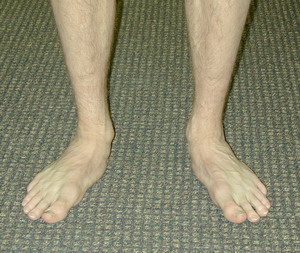| FOOT
DISORDERS - Flat Foot |
Flatfoot is a common condition, it is defined as
an abnormal depression of the medial longitudinal arch. These feet appear
collapsed with excessive turning out of the heel, and the inside of the foot
contacting the ground, this is the pronated foot type. It often has a
genetic component, and is more common in certain human populations and races.
Flatfoot is usually bilateral and apparent at an early age. It may be initially
asymptomatic, but often becomes progressively symptomatic with age. Some flat
feet never become bothersome. Adult acquired flatfoot may develop due to
trauma or degeneration of major tendons ankle & foot. Weakness or paralysis of
leg muscles can also create a flatfoot deformity. The medial arch is unstable in
flexible flatfoot, this creates stress on the surrounding soft-tissues and
joints creating tired, sore arches. The instability of the foot can create
abnormal stress up the kinetic chain - resulting in pain in the legs, knees,
hips and lower back. Patients with flat feet often present to the podiatrist
with problems that are indirectly caused by their foot structure.
Flatfeet suffer from inadequate support of the
bones and joints, and abnormal joint motion during gait. Fortunately, foot
orthotic devices can correct these problems and reduce the occurrence of painful
symptoms.. Generally, custom-made rigid functional posted orthotics are most
effective for this foot type. These devices are prescribed based on a thorough
biomechanical examination by a qualified podiatrist. Over-the-counter arch
supports may be helpful for mild cases, but often prove ineffective to relive
symptoms associated with flatfoot.

- Pain and stiffness of the medial arch or
anywhere along the mid-portion of the foot
- There may be associated discomfort within
and near the ankle joint
- The knees, hips, and lower back may be the
primary source of discomfort
- Feet may often feel tired and achy
- Painful shin splints may develop with
activity
- Gait may be awkward and apropulsive
- Genetic predisposition
- Faulty foot mechanics, e.g. excessive
pronation
- Abnormal bony architecture
- Laxity of ligaments
- Neuro-muscular disease
- Trauma to the leg muscles or major tendons
- Inflammatory diseases of the joints e.g.
Rheumatoid arthritis
- Surgical procedures on the leg and ankle
- Limb length inequality
- Tight Achilles tendon
- Wear shoes with a good fit in the arch
- Keep active and fit to strengthen leg and
foot musculature
- Control body weight to decrease load on the
feet
- Avoid prolonged periods weight bearing with
bare feet
- Apply orthopedic taping to support strained
ligaments and joints
- Prescribe physical therapy modalities
- Prescribe functional foot orthotic devices
to stabilize the foot and control motion
- Prescribe an ankle-foot orthosis when
greater control is required
- Surgically correct a severe symptomatic
flatfoot
- Severe heel pain from plantar fasciitis and
Achilles tendonitis
- Chronic strain and pain in the arch and
lateral side of the mid-foot
- Metatarsal stress fracture
- Early degenerative joint disease
(osteoarthritis) of lower extremity joints
- Flatfeet are more prone to conditions such
as bunions, hammer-toes, and Morton's neuroma
- Painful corns and calluses
- Structural changes may create areas of
abnormal pressure resulting in chromic ulcers of the foot
- Chronic foot pain may lead to inactivity and
diminished well-being


